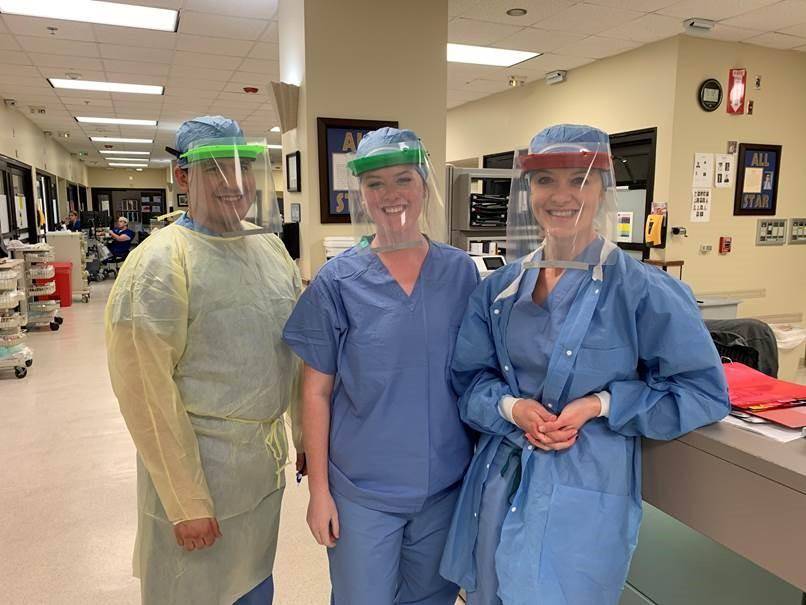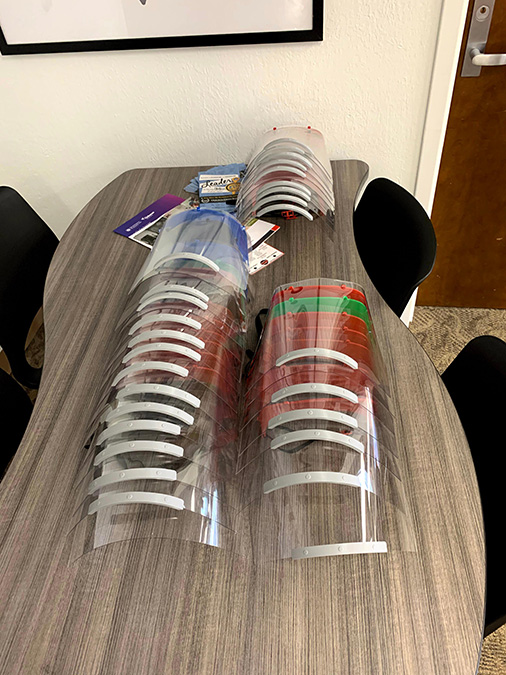West Texas 3D COVID-19 Relief Consortium Prints 3D Personal Protective Equipment for Health Care Workers
By: Kaitlyn Hale

In late February as the COVID-19 pandemic began to sweep into the United States, a physician assistant in Monahans, a small West Texas town almost three hours southwest of Lubbock, realized his hospital had a big problem.
Don Hillman took inventory at Ward Memorial Hospital, and the results were grim: The hospital had enough personal protective equipment to last the staff for one day, and only one ventilator.
Though 420 N95 masks were donated later, he knew it would only last so long, so he reached out to the Texas Tech University Whitacre College of Engineering and the Texas Tech University Health Sciences Center to see if they could assist in the shortage. Within a matter of days, the West Texas 3D COVID-19 Relief Consortium was born.
"I can't believe it," said Hillman. "Every time I turn around, this seems to have grown even larger."
The consortium, which aims to produce medical and personal protective equipment (PPE), initially focused on face shields. With a head piece that can be printed within a matter of hours, face shields can be assembled quickly and provide critical protection to health care workers.
"The reason why this is so important is that that when healthcare workers wear PPE like N95 masks and goggles, the quicker they get contaminated, the quicker they get changed," said Simon Williams, the associate dean for academic affairs at TTUHSC. "Face shields are in desperate need, not only in our small community hospitals, but in our clinics and also in our main hospitals."
Prototypes were created, based on modified designs from the internet, and then tested and validated by doctors. Williams said the consortium has been careful not to move too quickly, particularly with more complex medical equipment. The consortium originally began exploring concepts for N95 masks and ventilator splitters, but ultimately shifted focus to producing face shields and creating prototypes for emergency ventilators. Williams said that as the need for ventilators decreases across the nation, those prototypes may never advance to the production phase.

"We are working very closely with our partners to know what we would need to do to make sure that we can provide them with something that will be useful for them, but that they can also provide the verification for us to ensure that they're safe," Williams said.
The consortium is comprised of several teams that are focusing on specific issues, like assembling face shields and testing technology that can be used to sanitize equipment for reuse. Weilong Cong, an assistant professor in the Department of Industrial, Manufacturing & Systems Engineering, and his team of three graduate students originally worked on N95 mask prototypes, but decided not to continue with mass production after feedback from UMC. Instead, they began helping print the face shields and mask straps.
Cong and his students are using their own 3D printers as well as printers borrowed from the Whitacre College of Engineering to produce both face shields and mask straps. Since the consortium was founded, Cong said, their machines have been working nonstop.
Though the consortium has produced a larger total, Cong's team alone has produced more than 100 face shield brims and more than 350 mask straps.
Rural hospitals, which often work with less resources than their urban counterparts,
can be especially vulnerable to medical and personal protective equipment shortages.
"Rural hospitals throughout West Texas, we all operate on a shoestring budget," said
Dr. Hillman. "We may be open one year and gone the next."
Hillman, who has worked at the Ward Memorial Hospital in Monahans for almost 20 years, said that while the hospital has been able to save a lot of lives, it doesn't have the broad backup facilities, like an intensive care unit, that larger hospitals do.
"For the critically ill, we can stabilize them and get them to a larger facility," Hillman said. "UMC has always been an outstanding help to us, and one of the reasons I reached out to them was because they've always helped us with our critically ill patients."
Even as members of the consortium work around the clock to produce equipment, they are hoping that these supplies never have to be used.
"What we want to avoid is emergency situations where small rural hospitals become overwhelmed, so that they feel comfortable that they can meet at least a small number of patients' needs," Williams said.
The consortium has grown exponentially since Hillman's call in late February, and now more than 50 members of the consortium are working tirelessly to help health care workers across West Texas.
"I know how severe this case is, and I know how important it is for people to have masks," said Cong. "I admire and respect the doctors and nurses still on duty to take care of the patients, and I know how much risk they are exposed to, and we are considering how to try our best to help these heroes."
Discoveries
-
Address
Texas Tech University, 2500 Broadway, Box 41075 Lubbock, TX 79409 -
Phone
806.742.3905 -
Email
vpr.communications@ttu.edu
